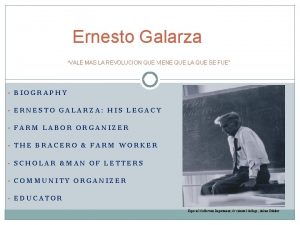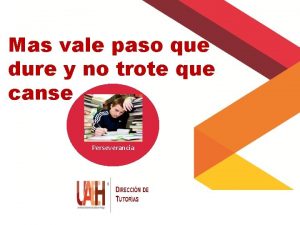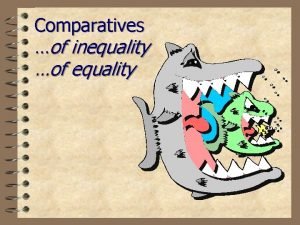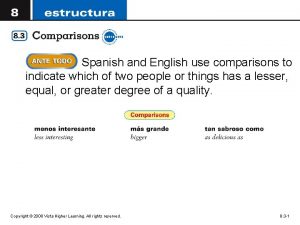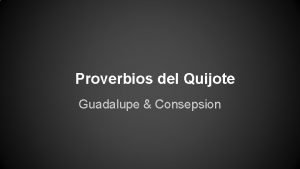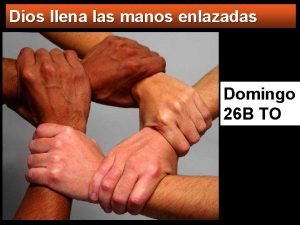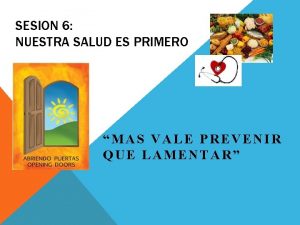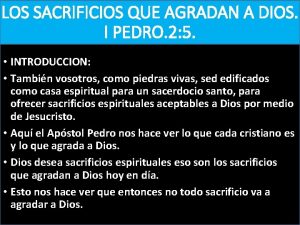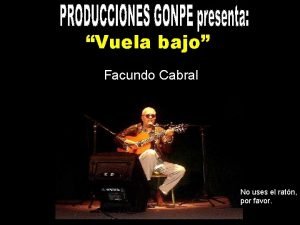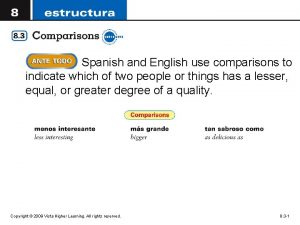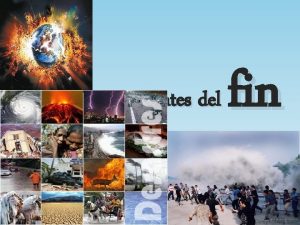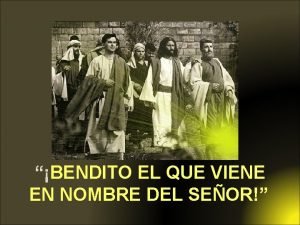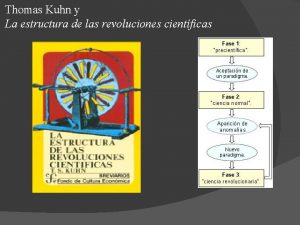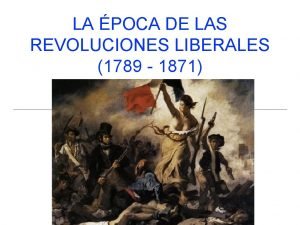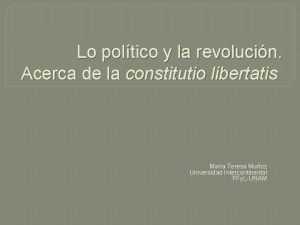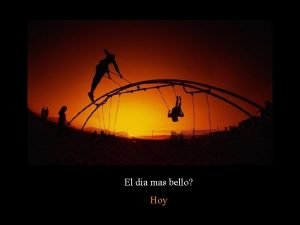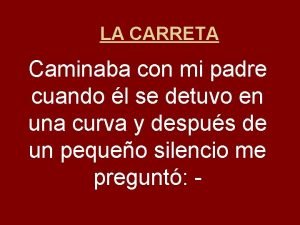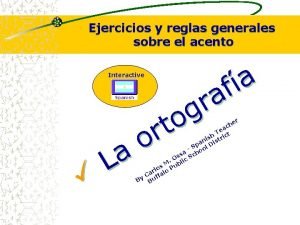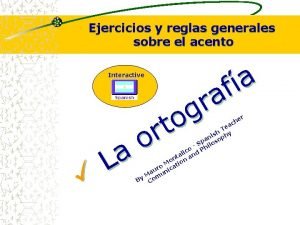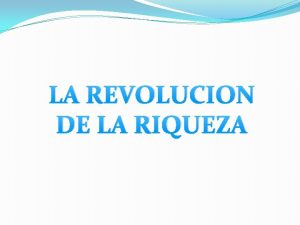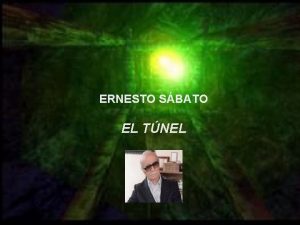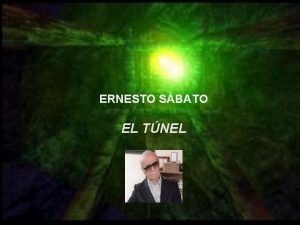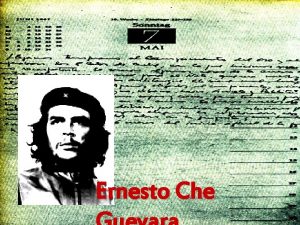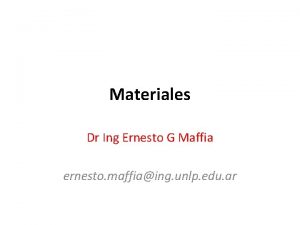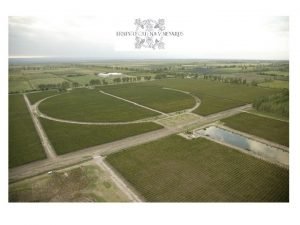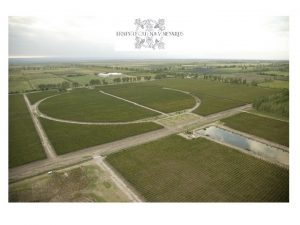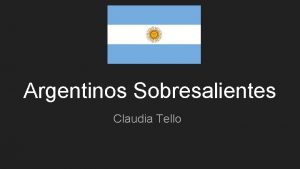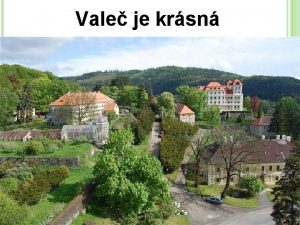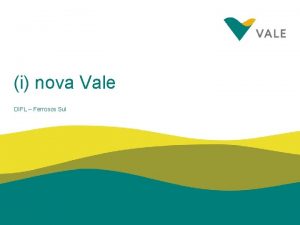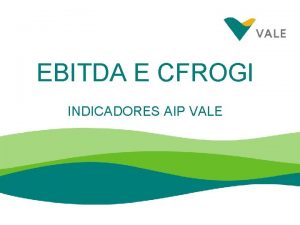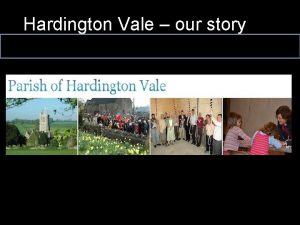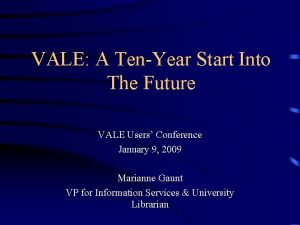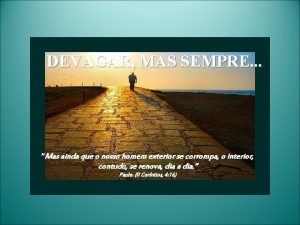Ernesto Galarza VALE MAS LA REVOLUCION QUE VIENE























- Slides: 23

Ernesto Galarza “VALE MAS LA REVOLUCION QUE VIENE QUE LA QUE SE FUE” • BIOGRAPHY • ERNESTO GALARZA: HIS LEGACY • FARM LABOR ORGANIZER • THE BRACERO & FARM WORKER • SCHOLAR &MAN OF LETTERS • COMMUNITY ORGANIZER • EDUCATOR Especial Collection Department, Occidental College, Online Exhibit

BIOGRAPHY 1905 -Born in Jalcocotan , State of Nayarit, Mexico 1911 -Migrated to the U. S. California (Sacramento) 1917 - Mother dies of Influenza 1923 - Attends Occidental College 1928 - Marries Mae Taylor (A SJSU Graduate) 1929 - Earns M. A. in History from Stanford 1932 -36 - Along with Mae established “Year-Long School” 1936 - Works for the Pan American Union 1947 - Earns Ph. D. from Columbia Occidental College, Online Exhibit Special collections Department, Occidental College, Online Exhibit 1947 -1954 - Serves as Vice President to the National Farm Labor Union 1947 -1953 - Organizes worker Strikes through out California and Louisiana 1954 -1963 - Serves as Secretary to National Agricultural Workers Union 1963 -64 - Appointed Adviser to the House Committee on Education & Labor 1979 - Nominated for Nobel Peace Prize in Literature 1984 - Dies at his Home in San Jose, CA Early days at labor organizing, Occidental college, Online Exhibit.

Who was Ernesto Galarza: His Legacy • Dr. Galarza was a Scholar, Activist, and Organizer who worked in response to the plight of the Mexican American Community. • From humble beginnings growing up in the agricultural fields of Sacramento, Ernesto Galarza would rise to become one of the pioneers and foremost shapers of the Mexican American/Chicano study and experience in the United States. • In the 1920 s Galarza was one of the handful of Mexican American/Chicano students to make it into college. • From 1923 to 1927 he attended Occidental College • In 1927 graduated from Occidental College with Phi Beta Honors. Special collections Department, Occidental College, Online Exhibit

Who was Ernesto Galarza: His Legacy In 1927 he was the first Mexican American ever admitted into graduate school at Stanford University. The first Mexican American/Chicano to obtain a Ph. D. in History and Political Science from Columbia University. First Mexican American to become a leader of a farm labor movement in the 1940 s (long before Cesar Chavez) First Mexican American to be nominated for the Nobel Prize in Literature. His legacy lives on, in the fields of Labor organizing, Advocacy for Workers, Children’s Education. Special collections Department, Occidental College, Online Exhibit

The Road to Labor Organizing • 1936 When the Spanish Civil War broke out and Hitler invaded Poland in 1939, Galarza determined that fighting fascism had greater priority over his academic work. • 1936 He joined the PAN American Union (today known as the Organization of Latin American States) and became a passionate and powerful voice against fascism in Latin America. • This delayed the completion of his doctoral dissertation until 1944. • After WWII, Galarza turned down excellent offers from, Harvard University and the United Nations. • Instead he accepted a job as an organizer with the Southern Tenant Farmer’s Union in Arkansas. • His reason for choosing the organizer job over a secure academic career, can best be understood in a letter he wrote to one of his sisters: “…I could not see myself cutting myself off from the world that really bore me-my mother’s world and that of its people. ” Special Collections Department, Occidental College Online Exhibit v. Initiated the Division of labor and Social Information for Latin America. v. He took on the cause of the poor and oppressed workers. v. Lobbied for their interest in public speeches, conferences, and meetings with high ranking Latin American government officials as well as within the U. S. Congress and State Department.

The Plight of the Braceros and Fight for farm workers to Unite Dr. Galarza spent over 12 years of his life as a labor leader and organizer in the struggle to empower Mexican American farm workers. He lead strikes and at the same time researched the inner workings of the agricultural corporations, the government agencies serving their needs of private wealth , and the oppressive conditions faced by Mexican Braceros and Chicano farm workers. (King City, CA. Ernesto Galarza) Several of his major works were extremely influential in contributing to the critical understanding of the role agribusiness and state political institutions played in the oppression of farm workers. Leonard Nadel, Bitter Sweet Harvest; Bracero Exhibit

Labor Organizing v 1947 - Accepted the job of Director of Research and Education in California for the Southern Tenant Farmer's Union. Which included black and white tenant farmers and agricultural laborers fighting for better wages, working conditions, and favorable legislation for small-scale farm workers. v 1947 -1954 -As Southern Tenant Farmer’s Union was renamed the National Farm Labor Union, Galarza became the vice president. v 1947 - Helped Organize strike against Di. Giorgio Fruit Corporation (0 ne of the first big strikes in California) v 1950 - Leads a Strike in Tracy, CA of tomato pickers. v 1951 - Leads a Strike in Imperial Valley, CA of Cantaloupe Pickers. v 1953 -54 -In Louisiana helps organize a strike with sugar cane workers and strawberry pickers. v 1954 - 1960 Served as Secretary to National Agricultural Workers Union. v 1960 - National Agriculture Workers Union became the Agricultural Workers Organizing Committee. v 1959 - He left Agricultural Workers Organizing Committee and labor organizing altogether.

Braceros • 1955 Galarza received funds from the Fund for the Republic to write a report on the Bracero Program (Mexican guest worker program created during WWII). • This report, Strangers in Our Fields, had immediate impact. His report exposed the abuses of the Bracero program. • He became a familiar face in congressional hearings concerning the Bracero program and the social economic status of Mexican Americans. • Three of his major works dealt with the critical understanding of the Bracero program, its effect on Braceros and U. S. workers, (many who were Mexican Americans) the exploitation they suffered and how it pushed them against each other, competing for the same jobs, at the benefit of agribusiness. Leonard Nadel, Bitter Sweet Harvest Bracero Exhibit

Braceros & Farm workers Merchants of Labor, he exposed the exploitation and deplorable conditions of Braceros, and became a critical study leading to the termination of the Bracero program by U. S. Congress. Spiders in the House and Workers in the Field, Dr. Galarza shows how laws, government regulations, and government agencies were manipulated to stop the struggle to unionized farm workers. Farm Workers and Agri-Business in California, captures the rise of agriculture corporate power in California. Leonard Nadel, Bitter Sweet Harvest Exhibition Leomard Nadel, Bitter Sweet Harvest Exhibit King City, CA ( Ernesto, Galarza)

Work After Labor Organizing In mid 1960 s he became a member of the Economic and Youth Opportunities and critically assessed the struggles of the urban Mexican American/Chicano community. Along with Dr. Julian Samora and Herman Gallegos work on the influential book Mexican Americans in the South West He became a Ford Foundation consultant and persuaded the Foundation to fund community programs aimed at resolution of social and economic problems of the barrios. He reviewed grant proposals submitted to the Ford Foundation by Mexican American groups one of which led to the establishment of the Southwest Council of La Raza in Phoenix. Elected Chairman of La Raza Unida Unity Conference in 1967 In the late 1960 s & early 1970 s Galarza served on the Board of Directors of the Mexican Legal Defense and Education (MALDEF) Most of the time however he devoted to teaching and writing. He was a Distinguished Visiting Professor at San Jose State University Honorary Fellow at UC Santa Cruz and Associate in Mexican American Problems at Harvard Graduate School

Man of Letters Dr. Galarza produced over a hundred works. He was a Man of letters, who wrote books, reports, speeches and journal articles. He was a social scientist, social critic and historian, a poet and a writer of children’s literature. His collective works have contributed to the development and foundation of Mexican American/Chicano studies as a interdisciplinary field of critical scholarship in the Universities. “Dr. Galarza left a legacy of intellectual accountability to any of us who are students, whether we are little children or middle school children, that we not only need to do our best, but must do our best because we represent our people” (Interview of Dr. Julia Curry Professor at San Jose State University, Mexican American Studies Department) Especial Collection Department, Occidental College Online Exhibit

Community Organizing : Alviso His work in Mexican Americans in the South West, signal Dr. Galarza’s move to focused his efforts in organizing the Mexican American working class population. In 1966 his concern for the urban plight of Mexican Americans had drawn him to Alviso, a small Mexican community north of San Jose. In 1968 the City of San Jose’s efforts to relocate existing residents and build new marinas, apartment complexes, a trade mart, light industry, and tourist facilities mean that Mexican American families in Alviso would, not only , loose their homes but their community. Dr. Galarza organized led and created the Alviso Study Team, which provided the necessary tools for the people of Alviso not only to organize themselves against redevelopment but to work for the advancement and betterment of their community. Mexican Americans in the South West (George Ballis)

Alviso: A Mexican Barrio In the 1940 s Alviso became home for many Mexican workers being displaced from jobs in agriculture and railroads because the land was cheap and it was close to other kinds of jobs. “Like many other Barrios, it became a labor pool for seasonal farm work and low –wage and part-time crafts and cervices” ( Galarza, In Defence of the Barrio) Alviso, California “…the barrios and colonias here have existed on what we might call marginal living spaces. The Mexican settled land that was not highly value by others at the time. ”(In Defense of the Barrio)

Community Organizing: Alviso Galarza was able to get the first grant ever awarded by the Ford Foundation to a Mexican American community for the creation of Community Health Center in the barrio of Alviso. The Health Center was a very much needed resource for the community. But Galarza worked for more than just the preservation of the Barrio, he explained in an Alviso Community Health Center, gardnerfamilyhealth. org/…/Alviso-ms. jpg. interview that , “…it doesn’t make much difference what we think about the preservation of the barrios as communities. I think the important thing is to look at what’s changing them … What happens after you save a barrio? It’s still a bad place to live in. Its still an unattractive place to live in. If you stop there you haven’t gone very far. ”

Work in Education • As a teacher, Galarza believed that the best way to learn was by doing. Form his own experience he knew that education was an instrument to empower and improve people’s lives. • 1930 s-Galarza and wife became co-directors of a progressive school in Long Island, New York, which they named the “ Long Year School” • They developed a curriculum which promoted the ideals and objectives of progressive education, considered at that time a radical approach to teaching. In the summer, students would spent time working on a farm. • Many years later, in 1971, Galarza was instrumental in establishing the Studio Laboratory for Bilingual Education, in San Jose, CA. , which emphasized a hands-on approach to teaching cultural values. Especial Collections Department, Occidental College Online Exhibit • This became a resource for the San Jose Unified School District.

Work in Education His collection of literature and poetry for children in his Mini-Libros (Mini-Books), made a valuable contribution to bilingual education as well as raising awareness of Mexican American culture in the United States. The motivation for his involvement in this area was his deep concern that Mexican American children be able to retain their culture and identity in the midst of their acculturation Excerpt from Aqui y Alla en California – Mini Libro His autobiography , Barrio Boy, was inspired to show that Mexicans as a whole did not suffer from an identity crisis. He believed that every Mexican American “had an abundance of self image and never doubted that it was a good one”. Especial Collections Department, Occidental College Online Exhibit Galarza signing copies of his autobiography Barrio Boy

Oral History Interview Dr. Julia E. Curry Asst Professor, Mexican American Studies Undergraduate, Adviser, Mexican American Studies Education Doctor of Philosophy, Sociology Univ Of Texas At Austin, United States, 1988 Master of Arts, Sociology Univ Of Texas At Austin, United States, 1986 Bachelor of Arts, Sociology Univ Of Cal-Santa Barba ra, United States, 1980 SJSU Faculty & Staff Web Pages

Sources for this Project Books by Galarza : Strangers in our fields. Based on a report regarding compliance with the contractual, legal, and civil rights of Mexican agricultural contract labor in the United States, made possible through a grant-in-aid from the Fund for the Republic, (Washington, 1956 ) Merchants of labor: The Mexican Bracero story; an account of time managed migration of the Mexican farm workers in California , 1942 -1960, (Charlotte, North Carolina, Mc. Nally, 1972) Zoo-risa; rimas y fotograffias de Ernesto Galarza, (Santa Barbara, Mc. Nally and Loftin, 1968) Mexican-Americans in the Southwest, by Ernesto Galarza, Herman Gallegos [and] Julian Samora. Photos. by George Ballis, (Santa Barbara, Mc. Nally and Loftin, 1969) Spiders in the House and Workers in the Fields , (Notre Dame, University of Notre Dame Press 1970) Aquí y alla en California. Texto y fotografías de Ernesto Galarza, ( San Jose, Calif. , Editorial Almadén, 1971) Rimas tontas. Ilustraciones de Arthur J. Schneida, (San Jose, Calif. , Editorial Almadén, 1971) Farm workers and agri-business in California, 1947 -1960 , (Notre Dame, University of Notre Dame Press, 1977) Alviso : the crisis of a barrio, (San Jose, Calif. : Mexican American Community Service Agency, 1973

Sources for this Project Barrio boy, (Notre Dame, University of Notre Dame Press 1971, printing) Farm workers and Agri-Business in California, 1947 -1960 , (Notre Dame, University of Notre Dame Press, 1977) Other sources: Mario Barrera and Geralda Vialpando, Action Research, In Defense of the Barrio: Interviews with Ernesto Galarza, Guillermo Flores and Rosalio Munoz, (Los Angeles, Aztlan Publications Pamphlet) Ernesto Galarza Commemorative Lecture 1987: Democracy and diversity / Cruz Reynoso, (Stanford, Stanford Center for Chicano Research, 1988 )

Archival Resources for this Project Stanford University. Libraries. Dept. of Special Collections and University Archives Title: Ernesto Galarza Papers, Date (inclusive): 1936 -1984 Collection number: Special Collections M 0224 Creator: Galarza, Ernesto Extent: 41. 5 linear ft. Box 1: Biographical and personal information about Galarza and many of his writings Box 2: Biographical and personal information about Galarza and many of his writings Box 3: Records of Tenant Farmer’s Union , the National Farm Labor Union, the National Agricultural Workers Union Box 18 Subseries B: Braceros (Conditions), 1943 -1964 Box 19 Subseries C: Braceros (Policy), 1943 -1967 SJSU Library, Special Research Collection Online, Cultural Heritage Center, Chicano Resource Center, History, Dr. Ernesto Galarza Publications.

Problems in Creating this Project Difficulties in doing a historical context for this project was the fact that I had to develop a historical context for an entire community. Even though Dr. Galarza did write a report of his project in Alviso in 1960, I had to do more research on the development of Alviso as a Mexican community back in the 1940 s which there was not much. I began by focusing on the house he grew up, in Sacramento, when he migrated with his from Mexico, but the building apartments have been destroyed to give way to a parking lot site. Finding photographs of Dr. Ernesto Galarza on books or any other materials. I ended up citing the photographs of different institutions that he was related to: Occidental College, Stanford University and the Stanford Center for Chicano Research, and Leonard Nadel his photographs were use by the Smithsonian to put the Bracero exhibit Bitter Sweet Harvest. Going through so many files in the Galarza papers at Stanford Special collection Archives , I only got to see just a few papers from each box archives, Dr. Galarza did so much in his life time its impossible for me to put all his achievements and work in this project. Sadly with all the information and wealth of knowledge that was able to find specially on the Stanford Archives, many people and specially within the Mexican American/Chicano community still don’t know the legacy of who Ernesto Galarza was. There is an Elementary School name in honor of him her in San Jose, but still the children who attend the school don’t really know who Ernesto Galarza was. I learned this from Dr. George Castro from the Dr. Ernesto Galarza Institute who as a potential project would like my services to do a small presentation or exhibit for the children at the school to learn who Ernesto Galarza was.

“The Revolution that will come is worth more than the one that is already in the past” “Ernesto Galarza” Especial Collection Department, Occidental College, Online Exhibit Ernesto Galarza (1905 -1984)

Power-point presentation by Armando Catalan Public History 197 Professor Margo Mc. Baine Phd. 05/22/10 Spring Semester 2010, SJSU.
 Ernesto galarza biography
Ernesto galarza biography Construye t 1.4 mas vale paso que dure
Construye t 1.4 mas vale paso que dure Comparison of equality ejemplos
Comparison of equality ejemplos Ernesto mira mas television que alberto
Ernesto mira mas television que alberto Quanto vale a paz quanto vale o sossego
Quanto vale a paz quanto vale o sossego Al bien hacer jamás le falta premio significado
Al bien hacer jamás le falta premio significado Manos de dios
Manos de dios Mas vale prevenir que lamentar
Mas vale prevenir que lamentar Mas vale sufrir una injusticia que cometerla
Mas vale sufrir una injusticia que cometerla Que es un sacrificio de alabanza
Que es un sacrificio de alabanza Vuela alto porque abajo esta la verdad
Vuela alto porque abajo esta la verdad Tú eres 1 of 1 (less) simpático que federico.
Tú eres 1 of 1 (less) simpático que federico. Hay quien pretende ser rico y no tiene nada
Hay quien pretende ser rico y no tiene nada Como ladron en la noche asi sera la venida
Como ladron en la noche asi sera la venida Bendito el que viene en nombre del señor
Bendito el que viene en nombre del señor Que es la revolucion cientifica segun kuhn
Que es la revolucion cientifica segun kuhn Que es una revolución política
Que es una revolución política Que es revolución
Que es revolución Mas alla de mis miedos mas alla
Mas alla de mis miedos mas alla El dia mas bello hoy
El dia mas bello hoy Caminaba un dia con mi padre cuando de pronto me pregunto
Caminaba un dia con mi padre cuando de pronto me pregunto Mas o más
Mas o más Tuvieron sus mas y sus menos mas luego terminaron amigos
Tuvieron sus mas y sus menos mas luego terminaron amigos Ejercicio lleva acento
Ejercicio lleva acento
